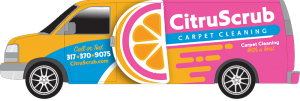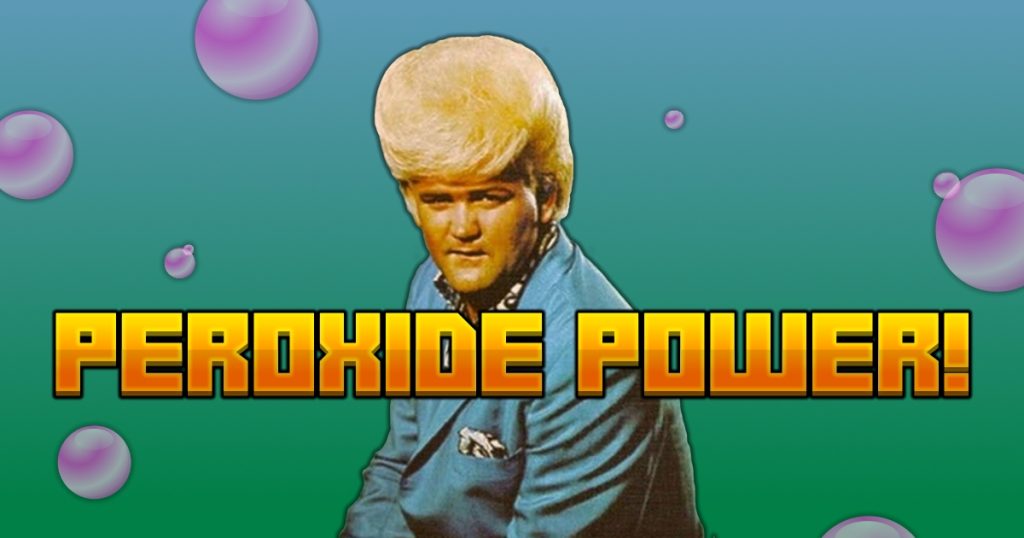
The secret to removing organic carpet stains is peroxide, and you’re about to learn more about it than you ever wanted to know.
Peroxide will not work on synthetic stains like artificial food dye. However, it works great on organic stains like…
- Blood
- Urine
- Feces
- Vomit
- Grass stains
- Coffee, tea and cola
- Wine
- Juice
- Other food and drink spills that don’t contain artificial dye
- Water stains (cellulosic browning)
- And pretty much anything else organic that ends up staining your carpet
I’ll tell you exactly how in this article. Before we start, I want to be clear I’m no chemist. I’m just a really, really good-looking carpet cleaner with a genius-level IQ (probably) and the physical strength of 10 men. See for yourself:

The point is, proceed at your own risk. If you damage your carpet or injure yourself, that’s on you, amigo. And if you happen to be an actual chemist and you notice mistakes below, please let me know via email. Now let’s talk about some carpet stains.
To start, hydrogen peroxide and peroxide are pretty much the same thing. For the purpose of this article, consider the terms interchangeable.
Peroxide comes in different strengths which are most commonly measured in either percentage or volume.
For example, the hydrogen peroxide you buy in the little brown bottle at the pharmacy is usually rated at three-percent, which would be 10-volume.
The percentage means that for every 100 milliliters of liquid inside the brown bottle, three percent is peroxide, and 97% is water.
On the other hand, the volume denotes how many milliliters of oxygen are released from one milliliter of liquid. In this case, one milliliter of three-percent hydrogen peroxide releases 10 milliliters of oxygen.
Yeah, yeah, I know it’s boring but this will be important because I’m going to tell you where to find peroxide, and I don’t want you to buy the wrong stuff.
Moving on…
No matter the strength, the percentage and volume are always relative. The percentage rating is always 30% of the volume rating. We’ve already established that three-percent peroxide is 10-volume. After all, three is exactly 30% of 10, correct?
Similarly, six-percent peroxide would be 20-volume. Nine-percent peroxide is 30-volume. Twelve-percent is 40-volume, and so on.
Now, here’s the thing… The stuff you buy in the little brown bottle at Walgreens is generally not strong enough to remove carpet stains. Again, drug store hydrogen peroxide is usually three-percent, or 10-volume. Boo! Too weak!
What you really want is something in the 12% range, which would be 40-volume. That’s the sweet spot. Any weaker and it won’t remove stains. Any stronger and it’ll melt your face off.
On that note, here’s where to buy it. You have a couple different options…
Where To Buy Peroxide
First, you can buy the exact same product I use in my business. It’s called Pro’s Choice Urine Stain Remover (USR). It comes in gallon containers. You can find it on eBay for about $20-25 per gallon plus $10-15 for shipping. In total, you’re looking at $30-40.
I’ve also seen it on Amazon, but it’s more expensive for whatever reason.
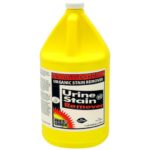
USR is roughly 10% peroxide, which is about 35-volume. It’s hard to know exactly because Pro’s Choice doesn’t publish the actual peroxide content. But it doesn’t really matter because it’s a fantastic, all-purpose stain remover that’s relatively safe to use.
If you don’t want to order online, here’s your second option… Go to a pool supply store and ask for a gallon of chlorine-free shock oxidizer. A popular brand is Aqua Silk, pictured below. It should be around $20-25 and you won’t need to pay for shipping. Just make sure to get liquid, not crystals or powder.
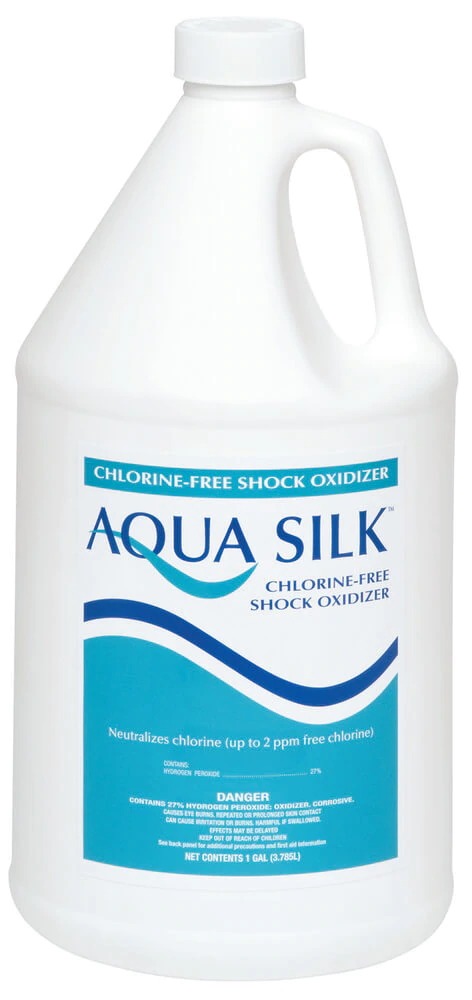
Aqua Silk is a little stronger than USR. The strength is about 12% peroxide, or 40-volume. I’ve used both products but haven’t seen a noticeable difference in performance, even though USR is slightly weaker.
I wouldn’t stray from these two products. Anything weaker than USR may not be effective. And anything past 12%/40-volume is too strong and too dangerous. It could bleach your carpet and cause serious burns on your skin.
That’s why I wanted you to understand percentages and volume-rating. Make sure the product you buy is in the range or 10-12%, or 35-40-volume.
PLEASE be safe when using any peroxide-based product. I don’t want to scare you away from using it–it’s not deadly or anything. But, like all chemicals, you need to respect it. And always use personal protection equipment. You’ve been warned, so I’m not responsible if you injure yourself or ruin your property.
How To Use Peroxide
A spray bottle is the best way to apply peroxide to carpet stains. You can use an empty, rinsed-out Windex bottle, or buy a trigger sprayer bottle from Lowe’s or Home Depot.
Be careful when pouring peroxide into a spray bottle. It burns if you get it on your skin. At 40-volume strength, it’s not enough to kill you, but it’s definitely painful. It also temporarily turns your skin white, which is a little freaky. I highly recommend rubber gloves and eye protection.
Here’s what happens if you get it on your skin:
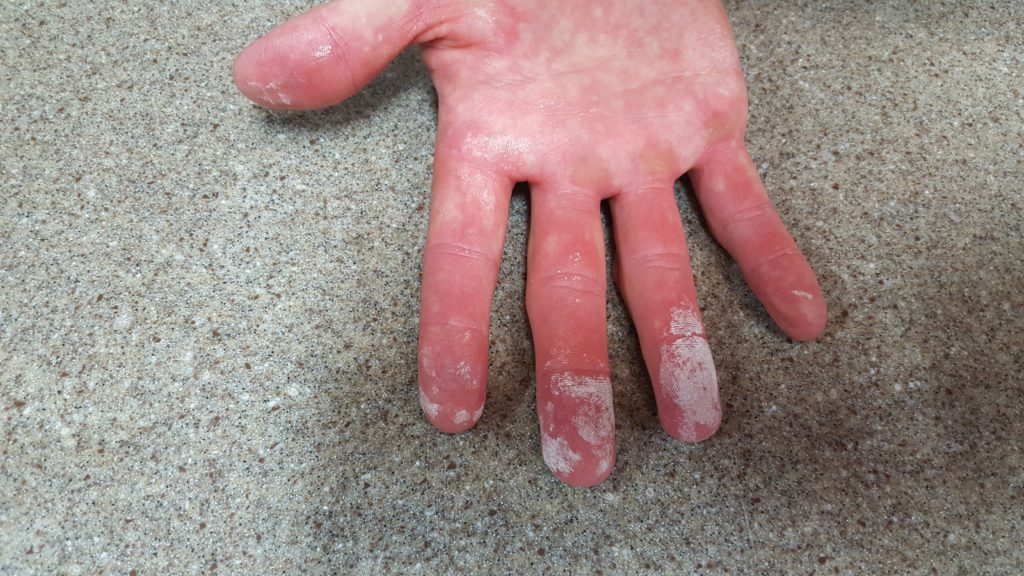
As you can see, my extremely manly fingertips have turned white and I was in a fair amount of pain when I took this picture. The sad part is, I poured peroxide on myself specifically to provide YOU with photographic evidence of what happens. So… you kinda owe me and stuff. I really like Famous Dave’s if you’d like to send a gift card.
Like I said, it won’t kill you, but it does cause discomfort. It’s best to wear proper protective gear, okay?
At this point, you’re probably asking yourself, “How does a discriminating sophisticate such as myself actually use peroxide to remove unsightly carpet stains?”
Ah, now we’re getting to the fun part!
First of all, you need to remember peroxide only works on organic stains like blood, urine, grass stains, wine, juice and tannin (which is found in coffee, tea and cola). It does not work on synthetic stains like artificial food dye.
It destroys organic stains with a chemical reaction called oxidation. Allow me to put that in very basic, caveman-like layman’s terms: “Peroxide done releases a buncha invisible oxygen molecules that makes stains get blowed up and die.”
However, you can’t just spray peroxide on a stain and expect it to disappear. You need to clean up as much excess material as possible.
For example, let’s say your cat yaks up a fur ball. Before using peroxide, you’ll need to remove as much solid material as you can. Blot or soak it up with towels or, more effective, suck it up with a Shop-Vac.
The idea is, you want all foreign material gone. All you should see is a leftover yellow stain.
Remember, peroxide can’t make solid material disappear, but it can make the yellow discoloration disappear. If you have some sort of severe problem with extra, contaminated material like cat urine, you’ll want to follow the steps in this article before you proceed.
Anyway, here’s what you do… You’ve already got your peroxide in a spray bottle, right? Simply mist the peroxide over the top of the stain. You don’t necessarily need to saturate it, just make sure the stain has nice, even coverage.
After that, all you have to do is wait. Don’t scrub it, don’t poke at it with a towel, don’t extract it. Just let the peroxide sit there and do it’s thing.
If possible, leave the lights on or open some curtains to let the sun in. Ultraviolet light–even in small amounts–can help the peroxide work better.
Which brings up another good point. Don’t cover the stain with anything other than clear, uncolored plastic. You want as much light as possible to reach the peroxide. You don’t necessarily need to cover the stain at all, unless you’re worried about kids or pets walking on it. In that case, use clear Saran wrap or something similar.
One time, I had an enterprising customer place a laundry basket over a large urine stain I’d just hosed down with peroxide. The basket allowed plenty of light in, but it kept her pets away from the treated area. I thought that was pretty genius.
As long as the peroxide is wet, it’s working, although it loses strength rapidly after coming into contact with the ambient air. It may take several hours for the stain to completely disappear.
If you still see the stain after the peroxide has dried, apply more. Just make sure the carpet is dry. Repeated applications without letting the carpet dry in between will soak the carpet and underlying pad. It’s not the end of the world, but it could take days to dry, which isn’t ideal.
It’s possible that some stains simply won’t come out. If a stain stops responding to peroxide after two or three applications, it’s probably permanent. Admit defeat, put on your most comfortable robe and slippers, grab a pint of ice cream and binge watch Friends on Netflix. At this point, that’s really your only option.
Store unused peroxide in a cool place out of direct sunlight. This will preserve its strength for future use.
If you leave peroxide in a spray bottle, make sure to label the bottle so you don’t forget what’s in it. I’d hate for you to think it’s water and spray it on your ficus.
When Not To Use Peroxide
Never use peroxide on natural fibers like wool or cotton. Severe damage and bleaching will occur.
In the United States, most wall-to-wall carpets are made from nylon, polyester or some other synthetic product. It’s perfectly safe to use peroxide on them.
However, some wall-to-wall carpets are wool. It’s rare, but it does happen. Most folks who have wool carpet are very well aware of the fact. If you have to ask, you probably don’t have it.
In addition, many area rugs are wool. Read the label on the back to be sure. Be careful with furniture, too. A lot of upholstery fabric contains cotton, so don’t accidentally overspray your expensive Haitian cotton sofa when you’re treating a nearby stain on the carpet.
And don’t forget, peroxide only works on leftover stains. IT WILL NOT WORK IF YOU DON’T REMOVE EXCESS MATERIAL.
If You’re Chicken
Of course, if you don’t feel like treating stains on your own and you live in the greater Indy area, I’d be happy to do it for you. Call or text me, Ross, at 317-370-9075 and I’ll get you fixed up. If you prefer email, click here to send a message.
Mic drop.
Peace out.








